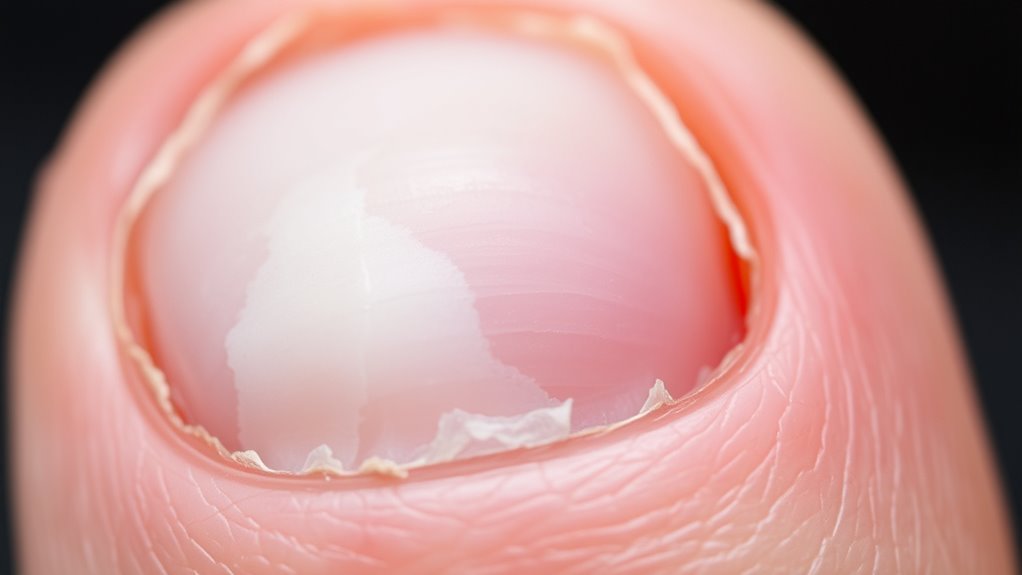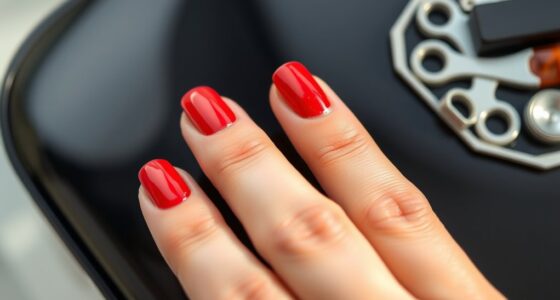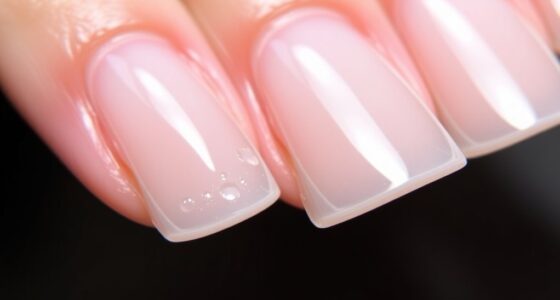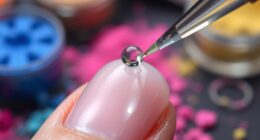Nail lifting, or onycholysis, often results from trauma, fungal infections, or underlying health issues. You may notice discoloration, thickening, or debris under the nail, which signals a problem. It’s important to keep your nails clean, dry, and avoid harsh chemicals. If symptoms worsen or pain occurs, see a doctor for proper treatment. To learn effective ways to manage and prevent onycholysis, keep exploring these helpful tips.
Key Takeaways
- Nail lifting often results from trauma, fungal infections, or repeated impacts that weaken the nail attachment.
- Recognizing symptoms like discoloration, thickening, or foul odor indicates possible infection requiring medical attention.
- Maintain good nail hygiene, keep nails dry, and use herbal remedies like tea tree oil to support healing.
- Medical treatments include antifungal medications and nail removal if necessary, to address underlying causes.
- Prevent future problems by avoiding harsh chemicals, protecting nails during activities, and practicing proper nail care.
Common Causes of Nail Lifting

Nail lifting often occurs due to underlying issues or external factors that damage the nail or its surrounding skin. Nail trauma is a common cause, happening when you accidentally bump or hit your nails, causing them to loosen. Repeated injuries or sudden impacts can weaken the nail’s attachment to the nail bed. Fungal infections also play a significant role; they can cause the nail to become discolored, thickened, and separate from the skin underneath. Fungal growth damages the nail structure, leading to lifting over time. Both nail trauma and fungal infections disrupt the healthy connection between your nail and nail bed, creating space where lifting can occur. Recognizing these causes helps you understand why your nail might be lifting and highlights the importance of protecting your nails from injury and infection. Additionally, protective nail care can help prevent further damage and promote healing.
Recognizing Symptoms and When to See a Doctor

Recognizing the symptoms of nail lifting is essential for determining whether you need medical attention. If you notice your nail separating from the nail bed, along with discoloration, thickening, or a foul odor, it’s time to see a doctor. Changes in nail hygiene, such as buildup of debris or fungal infection signs, should also raise concern. Stress management plays a role because persistent stress can weaken your immune system, making infections more likely. If you experience pain, swelling, or bleeding around the nail, consult a healthcare professional promptly. Early diagnosis helps prevent complications and guides appropriate treatment. Maintaining proper nail hygiene is crucial in preventing worsening symptoms and supporting healthy nails. Remember, keeping good nail hygiene and managing stress are crucial in preventing worsening symptoms and maintaining healthy nails.
Home Remedies and Self-Care Strategies

Taking proactive steps at home can help support nail health and potentially prevent further lifting. Good nail hygiene is essential; keep nails clean and dry to reduce infection risk. You can also try herbal remedies like tea tree oil or aloe vera, which have natural antifungal and soothing properties. Additionally, nurturing your nails with spiritual encouragement can promote a positive mindset during recovery. Here are some self-care strategies:
- Gently clean your nails daily and avoid harsh chemicals or excessive moisture.
- Apply herbal oils like tea tree or lavender oil to promote healing and reduce inflammation.
- Protect your nails by wearing gloves when doing chores or using nail-friendly products.
Consistency is key, and these simple measures can help support your nails during recovery. Remember, if symptoms worsen, consult a healthcare professional.
Medical Treatments for Onycholysis

Medical treatments for onycholysis typically involve addressing the underlying cause and preventing infection. If nail fungus is contributing to the lifting, your doctor may prescribe antifungal medications, either topical or oral, to eliminate the infection. In cases caused by nail trauma, treatment focuses on protecting the nail and allowing it to heal naturally. Keeping the affected nail clean and dry is vital to prevent bacterial or fungal infections. If infection develops, your healthcare provider might recommend antiseptic solutions or antibiotics. In some cases, removing the loose nail material can reduce discomfort and promote healing. Remember, proper diagnosis is essential to determine the right treatment plan. Always follow your healthcare provider’s advice to effectively manage nail fungus or trauma-related onycholysis. Understanding store hours can help you plan your visits to healthcare providers efficiently.
Preventing Future Nail Problems
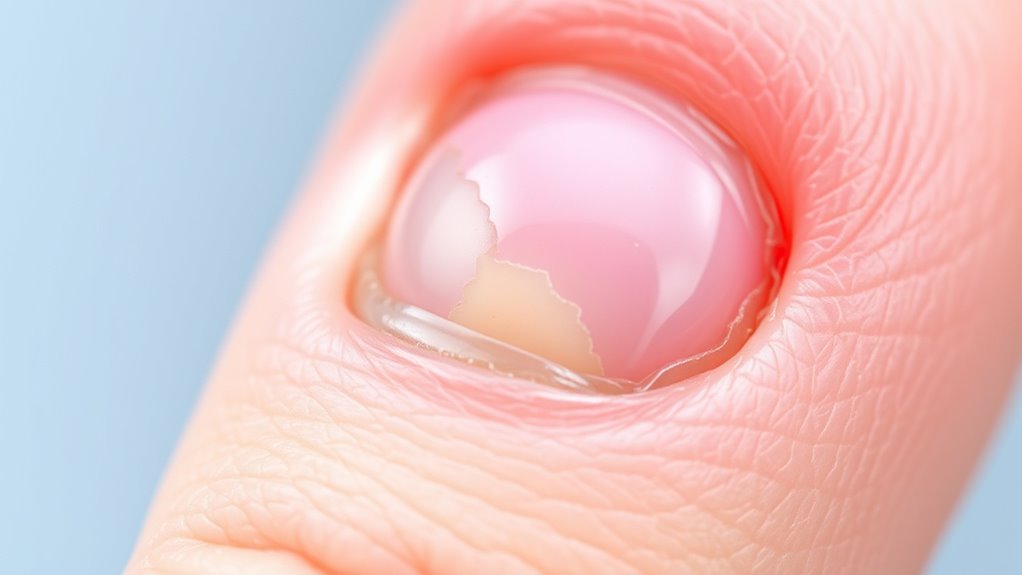
To prevent future nail problems, maintaining good nail hygiene and avoiding habits that damage the nails are essential. Proper preventive care helps preserve nail health and reduces the risk of issues like onycholysis. Using reliable tools and products can further ensure safe and effective nail care. Keep your nails clean and dry to prevent infections. Use gentle nail care tools and avoid harsh chemicals or excessive filing. Wear protective gloves when handling water or chemicals to shield your nails from damage.
Frequently Asked Questions
Can Nail Lifting Be a Sign of a Serious Health Condition?
Yes, nail lifting can indicate a serious health condition. If you notice persistent onycholysis, it might be linked to systemic health issues like thyroid problems or psoriasis. Nail infections can also cause lifting, signaling an underlying infection that requires attention. Don’t ignore ongoing nail changes; consult a healthcare professional to rule out serious conditions and get proper treatment. Early diagnosis ensures better management of any underlying health concerns.
How Long Does It Typically Take for Nails to Grow Back After Lifting?
Ever wonder how long it takes for your nails to fully grow back after lifting? Typically, nail growth is about 3 millimeters per month, so it can take 4 to 6 months for nails to regenerate completely. The healing timeline varies depending on your age, health, and nail care. During this period, you should keep the area protected and maintain good hygiene to promote healthy nail growth.
Are There Specific Nail Products That Can Prevent Onycholysis?
You can help prevent onycholysis by using nail strengthening products and protective coatings regularly. Look for nail polishes or treatments that contain strengthening ingredients like keratin or biotin, which help reinforce your nails. Applying a clear protective coating creates a barrier against damage and minimizes lifting. Be consistent with these products, avoid harsh chemicals, and keep your nails moisturized to support healthy growth and reduce the risk of nail lifting.
Is Onycholysis Contagious or Spread Through Contact?
Surprisingly, onycholysis isn’t contagious or spread through contact transmission, so you don’t have to panic sharing nail tools. The contagion risk is minimal unless caused by fungal infections or bacteria, which can spread through contact. Still, it’s wise to avoid touching or sharing contaminated items if you suspect infection. Remember, onycholysis often results from internal issues or trauma, not from others, so relax and don’t worry about catching it from a friend.
Can Dietary Changes Improve Nail Health and Prevent Lifting?
Yes, dietary modifications and nutritional supplementation can improve your nail health and help prevent lifting. By eating a balanced diet rich in biotin, zinc, iron, and vitamins A, C, and E, you support nail strength. Incorporate foods like nuts, eggs, leafy greens, and fish. Consider taking supplements if needed, but always consult a healthcare professional first. Improving your diet promotes healthier nails and reduces the risk of onycholysis recurrence.
Conclusion
Understanding the causes and management of nail lifting empowers you to take better care of your nails. Remember, onycholysis affects up to 5% of the population at any given time, making it more common than you might think. By recognizing symptoms early and adopting proper self-care, you can prevent complications and promote healthy nails. Don’t hesitate to consult a healthcare professional if needed—early intervention can make all the difference in restoring your nail health.
